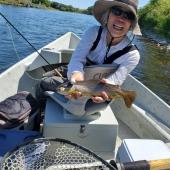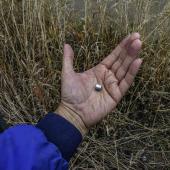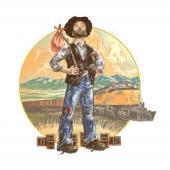Wild West Words: Yogo, Moose, Sioux, Gros Ventre • Cheyenne
Yogo • Moose Sioux, Gros Ventre • Cheyenne
Yogo
Etymologists have long wrestled with the origins of the word sapphire. English borrowed it directly from the Old French safir, which came from the Latin sapphirus, which came from the Greek sappheiros, which seems to have referred to lapis lazuli, another blue stone.
Here the etymological trail grows faint, but some scholars champion an older origin story hidden deep in Sanskrit, the classical language of India and Hinduism. They suggest sapphire is the etymological descendant of sanipryia, the Sanskrit word referring to a blue precious stone. Sanipryia means “dear to (the planet) Saturn.”
Yogo is the variety of sapphire found in central Montana. Named for the gulch in which it is found, this gem is typically cornflower blue, a color resulting from trace amounts of titanium and iron.
Prospectors quickly extracted what little gold there was in Yogo Gulch in the late 1800s. Abandoning the gulch for more sustainable gold claims, the miners left behind another species of mineral wealth: small, blue stones that when cut became brilliant sapphires.
Though prospectors clapped the ancient Sanskrit-Greek-Latin-French-English word sapphire on this stone, local legend has the word Yogo coming from the language of Piegan (Blackfoot), who traditionally inhabited the area and believed the word meant “blue sky.”
Moose
“The moose is…grotesque and awkward... Why should it stand so high at the shoulders? Why have so long a head? Why have no tail to speak of?” Such were the musings of 19th century naturalist and essayist Henry David Thoreau.
Author of Walden, or Life in the Woods, Thoreau was a student of local flora and fauna, including the long-headed, awkward-looking moose.
Writing in the mid-1800s, Thoreau may not have known that the creature existed everywhere in the northern tier of North America, from Thoreau’s Massachusetts, north and west to most Canadian provinces and Alaska, and down the Rocky Mountain spine from Montana to Colorado.
Ungainly at first glance, the moose is nevertheless exquisitely adapted to its environment, from its long legs for high brush and snow clearance, to its bulbous nose with nostrils that close during aquatic grazing. Moose are noted for stripping bark from deciduous trees such as willow, aspen, and birch.
This adaptation earned the animal its common name. The word moose comes from Algonquian, a language family spoken by natives of the east coast of Canada and the US. Translated into English, moose means “he strips off,” a reference to the creature’s distinctive browsing pattern. The word was spelled mus when it appeared in an English document dated 1614.
** Check out more of Chrysti the Wordsmith’s Entire collection of WILD WEST WORDS in Distinctly Montana's ARCHIVES by visiting distinctlymontana.com or by clicking HERE!

Sioux, Gros Ventre, and Cheyenne
Exonym and endonym are not common words, and that’s a pity because they are helpful in making sense of our world. An exonym is a name given to a place or a people by foreigners. An endonym is the people’s name for themselves and their habitations.
A familiar example of exonyms is the words Germany/German. These are the names that English speakers have imposed on that European country and its people. Deutschland/Deutsch are endonyms, the names the people call their country and its inhabitants. More exonym/endonym pairs: Prague/Praha, Rome/Roma, Naples/Napoli.
The names of many of North America’s native peoples have been exonymmed, sometimes by European colonists; other times by neighboring groups.
Sioux is the exonym of the people who call themselves Lakota, Dakota, and Nakota. The Ojibwe name for the people was Nadowessi, “Little Snake.” French-speaking traders pluralized the word with the suffix –oux. The result of this linguistic mash-up renders Nadowessioux, “Little Snakes,” which ultimately became Sioux. The people’s preferred endonyms, Lakota, Dakota, Nakota, mean “allies.”
The Atsina (“White Clay”) people traditionally lived near the Milk River in southern Saskatchewan and northern Montana. French traders and trappers gave them the exonym Gros Ventre (“Big Belly”) the misinterpretation of a tribal sign that drew the fingers across the chest and belly indicating a tattooing pattern customary among the people.
Cheyenne is the French spelling and pronunciation of a Dakota word variously translated “little Cree” or “relatives of the Cree.” This exonym supplants the plains dwellers’ name for themselves, Tsistsistas, “the people.” The Cheyenne called their traditional plains homeland Tsiihistano.












Leave a Comment Here